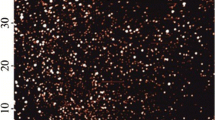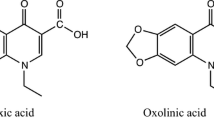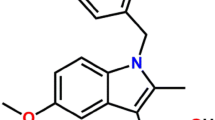Abstract
We performed a qualitative and quantitative analysis of intermolecular interactions in aqueous solution between the antitumor antibiotic mitoxantrone and C60 fullerene in comparison with interactions between the antibiotic and well-known aromatic molecules such as caffeine and flavin mononucleotide, commonly referred to as interceptor molecules. For these purposes, we obtained equilibrium hetero-association constants of these interactions using a UV/Vis titration experiment. Special attention was paid to the interaction of C60 fullerene with mitoxantrone, which has been quantified for the first time. Based on the theory of interceptor-protector action and using a set of measured equilibrium constants we managed to estimate the relative biological effect of these mixtures in a model living system, taking human buccal epithelium cells as an example. We demonstrated that C60 fullerene is able to restore the functional activity of the buccal epithelium cell nucleus after exposure to mitoxantrone, which makes it possible to use C60 fullerene as regulator of medico-biological activity of the antibiotic.







Similar content being viewed by others
References
Agarwal S, Jangir DK, Mehrotra R (2013) Spectroscopic studies of the effects of anticancer drug mitoxantrone interaction with calf-thymus DNA. J Photochem Photobiol B 120:177–182. https://doi.org/10.1016/j.jphotobiol.2012.11.001
Al-Otaibi JS, Wasli Y, ELGogary TM (2018) Theoretical and experimental studies on anticancer drug mitoxantrone. J Mol Struct 1173:837–847. https://doi.org/10.1016/j.molstruc.2018.07.020
Autrup H, Seremet T, Arenholt D, Dragsted L, Jepsen A (1985) Metabolism of benzo[a]pyrene by cultured rat and human buccal mucosa cells. Carcinogenesis 6:1761–1765. https://doi.org/10.1093/carcin/6.12.1761
Borowik A, Prylutskyy Yu, Kawelski Ł, Kyzyma O, Bulavin L, Ivankov O, Cherepanov V, Wyrzykowski D, Kaźmierkiewicz R, Gołuński G, Woziwodzka A, Evstigneev M, Ritter U, Piosik J (2018) Does C60 fullerene act as a transporter of small aromatic molecules? Colloids Surf B Biointerfaces 164:134–143. https://doi.org/10.1016/j.colsurfb.2018.01.026
Buchelnikov AS, Evstigneev VP, Evstigneev MP (2019) Hetero-association models of non-covalent molecular complexation. Phys Chem Chem Phys 21:7717–7731. https://doi.org/10.1039/C8CP03183E
Damiani RM, Moura DJ, Viau CM, Caceres RA, Henriques JAP, Saffi J (2016) Pathways of cardiac toxicity: comparison between chemotherapeutic drugs doxorubicin and mitoxantrone. Arch Toxicol 90:2063–2076. https://doi.org/10.1007/s00204-016-1759-y
Davies DB, Veselkov DA, Evstigneev MP, Veselkov AN (2001) Self-association of the antitumour agent novatrone (mitoxantrone) and its hetero-association with caffeine. J Chem Soc Perkin Trans 2:61–67. https://doi.org/10.1039/b007042o
Enache M, Toader A, Enache M (2016) Mitoxantrone-surfactant interactions: a physicochemical overview. Molecules 21:1356. https://doi.org/10.3390/molecules21101356
Evstigneev MP (2013) Physicochemical mechanisms of synergistic biological action of combinations of aromatic heterocyclic compounds. Org Chem Int 2013:1–10. https://doi.org/10.1155/2013/278143
Evstigneev MP, Lantushenko AO, Evstigneev VP, Mykhina YuV, Davies DB (2008) Quantitation of the molecular mechanisms of biological synergism in a mixture of DNA-acting aromatic drugs. Biophys Chem 132:148–158. https://doi.org/10.1016/j.bpc.2007.11.001
Evstigneev MP, Buchelnikov AS, Evstigneev VP (2019) The theory of interceptor-protector action of DNA binding drugs. Prog Biophys Mol Biol 149:131–146. https://doi.org/10.1016/j.pbiomolbio.2019.04.003
Golub A, Matyshevska O, Prylutska S, Sysoyev V, Ped L, Kudrenko V, Radchenko E, Prylutskyy Yu, Scharff P, Braun T (2003) Fullerenes immobilized at silica surface: topology, structure and bioactivity. J Mol Liq 105:141–147. https://doi.org/10.1016/S0167-7322(03)00044-8
Gołuński G, Woziwodzka A, Iermak I, Rychłowski M, Piosik J (2013) Modulation of acridine mutagen ICR191 intercalation to DNA by methylxanthines—analysis with mathematical models. Bioorg Med Chem 21:3280–3289. https://doi.org/10.1016/j.bmc.2013.03.043
Gołuński G, Borowik A, Wyrzykowski D, Woziwodzka A, Piosik J (2015) Pentoxifylline as a modulator of anticancer drug doxorubicin. Part I: reduction of doxorubicin DNA binding. Chem Biol Interact 242:291–298. https://doi.org/10.1016/j.cbi.2015.10.008
Golunski G, Woziwodzka A, Piosik J (2018) Potential use of pentoxifylline in cancer therapy. Curr Pharm Biotechnol 19:206–216. https://doi.org/10.2174/1389201019666180528084641
Grebinyk A, Prylutska S, Grebinyk S, Prylutskyy Y, Ritter U, Matyshevska O, Dandekar T, Frohme M (2019) Complexation with C60 fullerene increases doxorubicin efficiency against leukemic cells in vitro. Nanoscale Res Lett 14:61. https://doi.org/10.1186/s11671-019-2894-1
Grebinyk A, Prylutska S, Grebinyk S, Evstigneev M, Krysiuk I, Skaterna T, Horak I, Sun Y, Drobot L, Matyshevska O, Prylutskyy Yu, Ritter U, Frohme M (2021) Antitumor efficiency of the natural alkaloid berberine complexed with C60 fullerene in Lewis lung carcinoma in vitro and in vivo. Cancer Nanotechnol 12:24. https://doi.org/10.1186/s12645-021-00096-6
Hajihassan Z, Rabbani-Chadegani A (2009) Studies on the binding affinity of anticancer drug mitoxantrone to chromatin, DNA and histone proteins. J Biomed Sci 16:31. https://doi.org/10.1186/1423-0127-16-31
Hill GM (2011) Attenuation of cytotoxic natural product DNA intercalating agents by caffeine. Sci Pharm 79:729–747. https://doi.org/10.3797/scipharm.1107-19
Kapuscinski J, Ardelt B, Piosik J, Zdunek M, Darzynkiewicz Z (2002) The modulation of the DNA-damaging effect of polycyclic aromatic agents by xanthines. Biochem Pharmacol 63:625–634. https://doi.org/10.1016/S0006-2952(01)00904-2
Mosunov AA, Pashkova IS, Sidorova M, Pronozin A, Lantushenko AO, Prylutskyy YuI, Parkinson JA, Evstigneev MP (2017) Determination of the equilibrium constant of C60 fullerene binding with drug molecules. Phys Chem Chem Phys 19:6777–6784. https://doi.org/10.1039/C6CP07140F
Mosunov A, Evstigneev V, Buchelnikov A, Salo V, Prylutskyy Yu, Evstigneev M (2019) General up-scaled model of ligand binding with C60 fullerene clusters in aqueous solution. Chem Phys Lett 721:22–26. https://doi.org/10.1016/j.cplett.2019.01.051
Moura TA, Junior RLR, Rocha MS (2021) Caffeine modulates the intercalation of drugs on DNA: a study at the single molecule level. Biophys Chem 277:106653. https://doi.org/10.1016/j.bpc.2021.106653
Osowski A, Kasparek A, Wieczorek Z, Amarowicz R, Szabelski M (2017) Evaluation of the characteristics of some plant polyphenols as molecules intercepting mitoxantrone. Food Chem 227:142–148. https://doi.org/10.1016/j.foodchem.2017.01.083
Perillo E, Allard-Vannier E, Falanga A, Stiuso P, Vitiello MT, Galdiero M, Galdiero S, Chourpa I (2015) Quantitative and qualitative effect of gH625 on the nanoliposome-mediated delivery of mitoxantrone anticancer drug to HeLa cells. Int J Pharm 488:59–66. https://doi.org/10.1016/j.ijpharm.2015.04.039
Piosik J, Zdunek M, Kapuscinski J (2002) The modulation by xanthines of the DNA-damaging effect of polycyclic aromatic agents. Biochem Pharmacol 63:635–646. https://doi.org/10.1016/S0006-2952(01)00903-0
Piosik J, Gwizdek-Wiśniewska A, Ulanowska K, Ochociński J, Czyz A, Wegrzyn G (2005) Methylxanthines (caffeine, pentoxifylline and theophylline) decrease the mutagenic effect of daunomycin, doxorubicin and mitoxantrone. Acta Biochim Pol 52:923–926
Prylutska S, Politenkova S, Afanasieva K, Korolovych V, Bogutska K, Sivolob A, Skivka L, Evstigneev M, Kostjukov V, Prylutskyy Yu, Ritter U (2017) A nanocomplex of C60 fullerene with cisplatin: design, characterization and toxicity. Beilstein J Nanotechnol 8:1494–1501. https://doi.org/10.3762/bjnano.8.149
Prylutskyy YuI, Buchelnikov AS, Voronin DP, Kostjukov VV, Ritter U, Parkinson JA, Evstigneev MP (2013) C60 fullerene aggregation in aqueous solution. Phys Chem Chem Phys 15:9351–9360. https://doi.org/10.1039/c3cp50187f
Prylutskyy YuI, Cherepanov VV, Kostjukov VV, Evstigneev MP, Kyzyma OA, Bulavin LA, Ivankov O, Davidenko NA, Ritter U (2016) Study of the complexation between Landomycin A and C60 fullerene in aqueous solution. RSC Adv 6:81231–81236. https://doi.org/10.1039/C6RA18807A
Ritter U, Prylutskyy YuI, Evstigneev MP, Davidenko NA, Cherepanov VV, Senenko AI, Marchenko OA, Naumovets AG (2015) Structural features of highly stable reproducible C60 fullerene aqueous colloid solution probed by various techniques. Fuller Nanotubes Carbon Nanostruct 23:530–534. https://doi.org/10.1080/1536383X.2013.870900
Shckorbatov YG, Pasiuga VN, Kolchigin NN, Grabina VA, Batrakov DO, Kalashnikov VV, Ivanchenko DD, Bykov VN (2009) The influence of differently polarised microwave radiation on chromatin in human cells. Int J Radiat Biol 85:322–329. https://doi.org/10.1080/09553000902781113
Skamrova GB, Laponogov I, Buchelnikov AS, Shckorbatov YuG, Prylutska SV, Ritter U, Prylutskyy YuI, Evstigneev MP (2014) Interceptor effect of C60 fullerene on the in vitro action of aromatic drug molecules. Eur Biophys J 43:265–276. https://doi.org/10.1007/s00249-014-0960-2
Thordarson P (2011) Determining association constants from titration experiments in supramolecular chemistry. Chem Soc Rev 40:1305–1323. https://doi.org/10.1039/C0CS00062K
Traganos F, Kaminska-Eddy B, Darzynkiewicz Z (1991) Caffeine reverses the cytotoxic and cell kinetic effects of Novantrone (mitoxantrone). Cell Prolif 24:305–319. https://doi.org/10.1111/j.1365-2184.1991.tb01159.x
Veselkov AN, Evstigneev MP, Rozvadovska AO, Mukhina YuV, Davies DB (2005) A structural and thermodynamic analysis of novatrone and flavin mononucleotide heteroassociation in aqueous solution by 1H NMR spectroscopy. Russ J Bioorg Chem 31:453–459. https://doi.org/10.1007/s11171-005-0062-0
Wang S-L, Lee J-J, Liao AT (2016) Comparison of efficacy and toxicity of doxorubicin and mitoxantrone in combination chemotherapy for canine lymphoma. Can Vet J Rev Vet Can 57:271–276
Woziwodzka A, Gołuński G, Wyrzykowski D, Kaźmierkiewicz R, Piosik J (2013) Caffeine and other methylxanthines as interceptors of food-borne aromatic mutagens: inhibition of Trp-P-1 and Trp-P-2 mutagenic activity. Chem Res Toxicol 26:1660–1673. https://doi.org/10.1021/tx4002513
Woziwodzka A, Krychowiak-Maśnicka M, Gołuński G, Felberg A, Borowik A, Wyrzykowski D, Piosik J (2021) Modulatory effects of caffeine and pentoxifylline on aromatic antibiotics: a role for hetero-complex formation. Molecules 26:3628. https://doi.org/10.3390/molecules26123628
Xie X-W, Liu Z-P, Li X (2020) Design, synthesis, bioevaluation of LFC- and PA-tethered anthraquinone analogues of mitoxantrone. Bioorg Chem 101:104005. https://doi.org/10.1016/j.bioorg.2020.104005
Acknowledgements
This work was financially supported by the Ministry of Science and Higher Education of the Russian Federation (project no. FEFM-2020-0003). The authors thank the Resource center ‘Molecular structure of matter’ of Sevastopol State University for access to equipment.
Author information
Authors and Affiliations
Corresponding author
Ethics declarations
Conflict of interest
The authors declare no conflict of interests.
Additional information
Publisher's Note
Springer Nature remains neutral with regard to jurisdictional claims in published maps and institutional affiliations.
Electronic supplementary material
Below is the link to the electronic supplementary material.
Appendix: Calculation of the A D factor
Appendix: Calculation of the A D factor
The AD factor is calculated according to Eq. (7):
where θX and \(\theta_{X}^{\left( 0 \right)}\) are the mole fractions of NOV-DNA complexes in the presence and in the absence of interceptor molecules, respectively. Therefore, the calculation of the AD factor is reduced to calculation of these mole fractions.
Consider a three-component system containing mitoxantrone molecules (X), interceptor molecules, i.e., caffeine, flavin mononucleotide or C60 fullerene (Y), and DNA (N). Let us introduce the total concentrations of these species as x0, y0 and N0, respectively. Note, the DNA concentration is measured in moles of base pairs per liter. To describe non-cooperative DNA binding we use standard approach taken from Ref. (Evstigneev et al. 2008).
For such a system, the mass balance equations are written in general form as follows (Evstigneev et al. 2019):
where xhet, yhet are the overall concentrations of X- and Y-containing hetero-aggregates including monomers, respectively; x1, y1 are the monomer concentrations of X and Y compounds; N1 is the concentration of free DNA; KXN, KYN are the equilibrium constants of X and Y monomers bound to DNA. Equation (9) can be easily rewritten to
The θX quantity is given as
Now, we can easily reduce Eq. (10) to obtain the equation for calculation of the \(\theta_{X}^{\left( 0 \right)}\) quantity by mental exclusion of interceptor molecules from the system. This is expressed in zeroing of all the terms in Eq. (10) related to Y molecules. Thus, one obtains the equation
to be solved for \(\theta_{X}^{\left( 0 \right)}\) as \(\frac{{K_{XN} x_{1} }}{{1 + K_{XN} x_{1} }}\).
The explicit form of the xhet and yhet quantities depends on particular model of hetero-association which, in turn, is selected upon the type of interacting molecules. We study the interceptor molecules of two different types, viz. aromatic ligands (caffeine and flavin mononucleotide) containing planar chromophore which makes molecules be able to form stacking complexes with similar compounds and DNA, and C60 fullerene possessing specific affinity to aromatic ligands which mitoxantrone belongs to. Moreover, C60 fullerene is assumed not to bind with DNA (see “Description of biological data within the framework of the IPA theory” of the paper). Therefore, we should consider two cases of competitive DNA binding.
Case 1: caffeine and flavin mononucleotide are the interceptor molecules
To describe the aggregation of aromatic compounds, such as caffeine and flavin mononucleotide, with mitoxantrone we use 1:2 hetero-association model (Thordarson 2011). The corresponding mass balance equations are given in Eq. (2) in “Hetero-association model for the antibiotic and aromatic interceptors, CAF/FMN” of the paper. They exactly equal to the xhet and yhet quantities in Eq. (10). Thus, one obtains:
Putting y1 = 0 in Eq. (13) yields:
which has exact solution in the following form:
Hence, we readily obtain the expression for the \(\theta_{X}^{\left( 0 \right)}\) quantity:
Numerical solution of Eq. (13) allows one to obtain the θX quantity to be further substituted into Eq. (8) along with Eq. (16) to calculate AD factor for NOV-CAF-DNA and NOV-FMN-DNA systems.
Case 2: C60 fullerene is the interceptor molecule
To describe the aggregation in NOV-C60 system we use up-scaled model (Mosunov et al. 2019). Similarly to the above, the xhet and yhet quantities are given as the first and the second equation, respectively, in Eq. (4) in “Complexation model for the antibiotic and C60 fullerene” of the paper.
The exclusion of protector mechanism of action, i.e. DNA binding of C60 fullerene, results in KYN = 0. Hence, the set of equations to calculate θX in the form of \(\frac{{K_{XN} x_{1} }}{{1 + K_{XN} x_{1} }}\) is written as:
where CD0, CD1 were substituted for x0, x1, respectively.
Setting CR1 and CM to zero in Eq. (17) yields the equation similar to Eq. (14). Thus, one can numerically solve Eqs. (17), (16) to obtain the θX and \(\theta_{X}^{\left( 0 \right)}\) quantities, respectively, and further substitute them into Eq. (8) to calculate AD factor for NOV-C60-DNA system.
Table
3 summarizes all the parameters needed to calculate the AD factor for both cases.
Rights and permissions
About this article
Cite this article
Salo, V.A., Buchelnikov, A.S. & Evstigneev, M.P. Interceptor potential of C60 fullerene aqueous solution: a comparative analysis using the example of the antitumor antibiotic mitoxantrone. Eur Biophys J 51, 297–307 (2022). https://doi.org/10.1007/s00249-022-01597-x
Received:
Revised:
Accepted:
Published:
Issue Date:
DOI: https://doi.org/10.1007/s00249-022-01597-x




